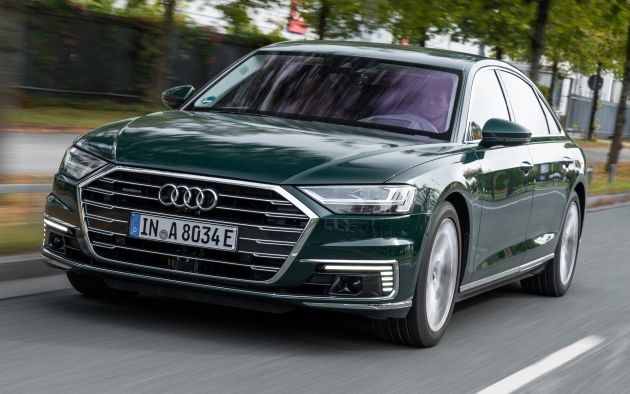D5 Audi A8L 60 TFSI e quattro plug-in hybrid – 449 PS, 700 Nm, 2.5 litres per 100 km, 46 km electric range
Audi is continuing the electrification of its entire range – the latest D5 A8, already fitted with a 48-volt mild hybrid system across the lineup, now receives a proper plug-in hybrid in the form of the A8 L 60 TFSI e quattro. It’s a long name, yes, but the “60” designation means that this car has the equivalent performance of the regular 60 TFSI, which is powered by a 460 PS/600 Nm 4.0 litre twin-turbocharged V8.
This 60 TFSI e instead gets motive force from a 3.0 litre turbo V6 from the 55 TFSI (or 3.0 TFSI, as it is sold here), making 340 PS and 500 Nm of torque. To make up for this shortfall, the PHEV gains an electric motor integrated with the clutch in the eight-speed torque converter automatic transmission, churning out an extra 100 kW (136 PS) and 350 Nm.
Together, they deliver a total system output of 449 PS and 700 Nm, the latter produced from 1,250 rpm. That’s 11 PS less than the V8-powered model but 100 Nm more, allowing the luxury sedan to sprint from zero to 100 km/h in 4.9 seconds (three tenths slower than the 60 TFSI), before hitting an electronically-limited top speed of 250 km/h. As the name suggests, the car comes with quattro all-wheel drive as standard.
Juice is provided by a 14.1 kWh, 385-volt lithium-ion battery, with all eight modules and 104 cells located under the boot floor. This enables the car to provide a combined fuel consumption figure of 2.5 to 2.7 litres per 100 km, as well as an WLTP-rated all-electric range of 46 km. The battery features a coolant circuit linked to the four-zone automatic climate control, which also utilises waste heat from the high-voltage componentry.
Unlike many plug-in hybrids, the TFSI e defaults to electric mode, only engaging the internal combustion engine when the accelerator is depressed beyond a certain point. The “Hybrid” mode has “Auto” and “Hold” settings, the latter saving the battery charge for later use. The car uses navigation and traffic data to maximise the efficiency of the powertrain, as well as ride comfort.
It also uses data from the driver assistance systems to decide whether to recuperate energy or sail with the engine off, depending on the distance to the car in front. The adaptive cruise control will also assist the driver in accelerating efficiently, and when it’s off, a haptic throttle will let the driver know when it’s time to take their foot off the pedal. The electric motor can recuperate up to 25 kW when coasting and up to 80 kW when braking, and it can decelerate the car up to 0.3 g through recuperation alone.
Standard equipment includes an acoustic vehicle alerting system (AVAS) that pedestrians can hear clearly at speeds of up to 20 km/h; the sound will gradually fade out as speeds increase. The car also comes with a charging cable for use at public charging stations, and customers in Germany can get renewable energy for their home (and thus, their car) through the Volkswagen Naturstrom service. A proprietary Audi e-tron Charging Service provides access to more than 110,000 charging points in Europe.
Customers can also use the myAudi app to view various vehicular data such as battery charge, range and fuel consumption, as well as to start charging, programme the charge timer and set the pre-entry climate control function before setting off. Visual cues that separate the TFSI e from the regular A8 include daytime running light strips at the corners of the front bumper and 19-inch five-spoke turbine-style alloy wheels.
The A8 L 60 TFSI e is now open for booking in Germany with a starting price of €109,000 (RM506,700), ahead of a market launch starting in the fourth quarter. While the car is only offered in long-wheelbase form at the moment, a standard-length variant will be available a few weeks later. This is Audi’s fourth PHEV to go on sale, after the Q5 50 TFSI e and 55 TFSI e versions of the Q5 and A7 Sportback.

























The post D5 Audi A8L 60 TFSI e quattro plug-in hybrid – 449 PS, 700 Nm, 2.5 litres per 100 km, 46 km electric range appeared first on Paul Tan's Automotive News.
from Paul Tan's Automotive News
Read The Rest:paultan...










Post a Comment